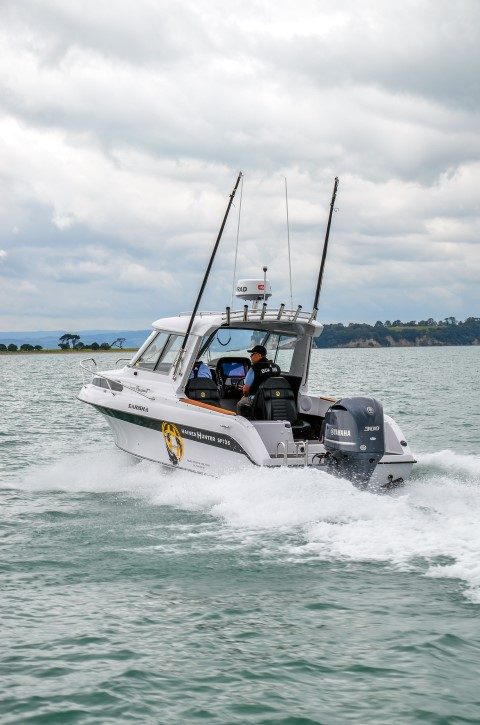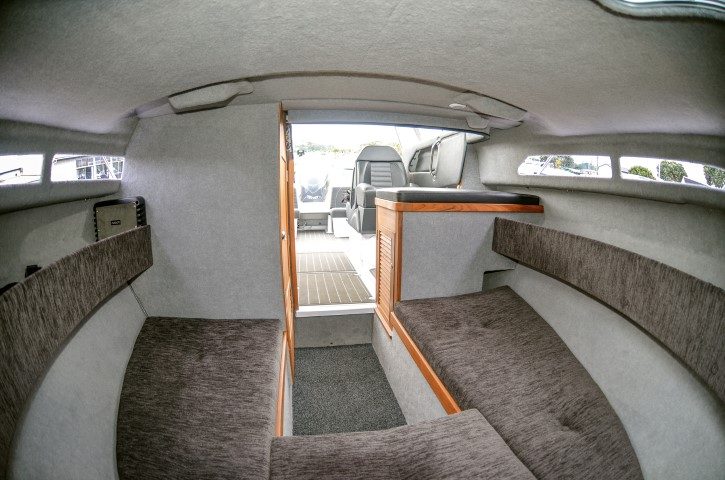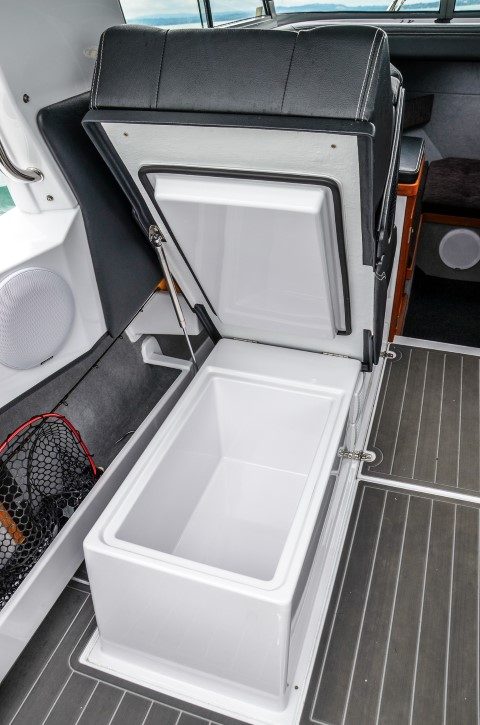‘Behemoth’ is a word which springs to mind or, perhaps more nautically, ‘leviathan’.

Recently updated and refreshed, the SP725 is one of Haines Hunter’s premium models. Sarisha is the company’s demo vessel, so nearly every box on the extensive options list has been ticked, including the one for a 4.2-litre 300hp V6 Yamaha outboard.
The 725 series incorporates three models, all sharing the same hull and deck, but with different cabin layouts. The SS725 has a fully enclosed cabin , the SP725 (as featured) has an open-style cabin for a more social experience and the flagship SE725 is one of only a handful of New Zealand-built fibreglass boats with a fully enclosed wheelhouse.

As befits a premium model, Haines Hunter has specified a top-of-the-line, heavy-duty DMW Premier Series tandem trailer under the boat. Featuring classy-looking alloy wheels and a central walkway, the trailer is braked on both axles with stainless steel calipers and rotors. On the road, the rig weighs in at around 2,600kg, so an electric-over-hydraulic Sensa-Brake system gives peace of mind when towing it.
A prominent feature of the trailer is the Balex Automatic Boat Loader, a piece of equipment that’s increasingly requested, explained Seacraft’s Dennis McCorkindale. The Balex makes launching and retrieving the boat a breeze, as Dennis demonstrated during our review.
The 2018 model SP725 is an open hardtop sedan model with overnighting capacity. The interior layout has remained largely unchanged since the model was first released in 2011, but the helm console has been updated to accommodate today’s large multi-function displays, in this case a Simrad 16-inch unit.
The 725 Series was developed in 2011 as a replacement for the popular 700 Series after most of the moulds were destroyed in a disastrous factory fire in 2010. Lionel Sands and Denis Kendall, owners of Haines Hunter NZ Ltd, made a substantial commitment and embarked on the task of producing the replacement model, taking onboard new technology and input from their dealer network.

By taking advantage of CAD design technology and using the existing 700 as the base design, they enhanced the new 725 by adding length and beam. The slightly larger 725 Series offered more spacious interior layouts, superior handling and better performance, but maintained the fine pedigree of its predecessors, which is very evident in Sarisha.
New mouldings
The SF725’s new helm console has plenty of space for modern electronics. On this boat all the gauges are electronic, including Yamaha’s Command Link display and separate displays for the electronic steering and Zipwake automatic trim tabs. The VHF radio and Fusion Apollo Bluetooth stereo are housed in the hardtop console above the windscreen.
The other major update to the new SP725 is the floor. Covered in soft-touch, light-grey Ultralon U-Deck panels, it’s a moulded composite PVC foam sandwich that’s bonded to the hull, creating watertight chambers under the floor that provide the vessel’s reserve buoyancy.
The cockpit’s moulded side pockets are part of the floor structure, but the new floor is not a drop-in hull liner, as used by some other manufacturers in conjunction with expanding foam for buoyancy, but rather a structural component of the hull. The floor contains no wood, so rot is never going to be an issue, and water can’t find its way into the hull.
Structural floors were pioneered with the Haines Hunter 485 (Boating NZ, July 2009), and later incorporated in the 725 and 545 models. They will soon be extended to the rest of the Haines Hunter model range.
The composite floors are not only stronger and lighter than the marine plywood floors they replaced, they are also easier to clean and should still be as good as new when the boat is 20 years old.
Classic lines
There’s a timelessness to the appearance and interior ambience of this large CPC-rated trailer boat. What you see is what you get – a solid, handsome, nicely appointed vessel that will do whatever you want it to do, whether that’s fishing, diving, overnight expeditions, day trips, or enjoying family watersports fun.
Haines Hunter’s demo boat has all the fruit, from Simrad 4G broadband radar to a dual fairlead and split bowrail for deploying a reef anchor or tying up to a mooring. The vessel has top quality Ocean Blue telescopic outriggers, an LED light bar on the hardtop roof and LED underwater lights.

The auto winch is a Profish free-fall model, operated from the helm, there’s a Delta anchor, and the hull has the standard brass keel strip to protect its gelcoat should you contact the boat ramp or beach.
Haines Hunter maintains the high-quality upholstery and they can also supply rear drop-covers, camper packs to enclose the cockpit when overnighting, and storage covers.
Less immediately obvious are the vessel’s through-hull transducers, three of them. A centreline Structure Scan transducer giving 50/200 kHz echo plus the Structure Scan giving Down-scan with Fish Reveal, plus left and right scanning.
Either side of the centreline are 175kHz through-hull CHIRP transducers, one giving High Wide CHIRP with 200kHz echo with wide beam and the other a low beam 50kHz CHIRP for deep water targeting deep water species. The Structure Scan plugs straight into the back of the MFD while the other two transducers run through the Simrad S5100 Sonar Module.

Sarisha’s Simrad NSS evo3 touch-screen display has built-in GPS and uses C-Map charting. If desired, engine data can be displayed on the MFD, along with other inputs such as the stereo.
A Simrad autopilot module is also fitted, which can be operated by using the touch-screen display or via Simrad’s handy OP50 click-wheel control unit beside the helm seat. the remote control falls nicely to hand and allows you to navigate through the MFD’s screens and menus and steer the boat when the autopilot is engaged.
Function and style
The cockpit is a practical, workable space. There’s built-in rod storage in racks under the coamings, which feature teak covering boards and two flush-mounted stainless-steel rod holders per side, angled for trolling duties.
Across the transom additional rod holders will accommodate the rest of the trolling spread, or Haines Hunter’s moulded GRP bait station (also with rod holders), which can be mounted centrally or to either side of the transom.
Corner seat-bins, a feature of many Haines Hunter models, are easily removed to provide more cockpit space and better transom access. Their padded and upholstered backrests hinge upwards to reveal the batteries – one house and one starting, linked, to cope with the power demands of multiple electric and electronic devices – isolation switches, fuel filters, electric steering pump, washdown, live well and freshwater pumps.
The generous-sized live-well is located in the swim platform on the port side, there are 12-volt power outlets either side of the cockpit for electric reels, and LED cockpit lighting, including a floodlight. As well as six rod and reel combos in racks along the boat’s sides, the folding rocket launcher can hold another six, angled vertically.
Comfort-plus
Under the fully-lined hardtop, everything is nicely detailed. Padded vinyl-covered panelling, nicely finished marine vinyl upholstery and supportive king and queen-style seats take care of passenger comfort, while the lined forward cabin features plush fabric upholstery and good seated headroom.
An infill creates a good-sized double berth, while a separate head compartment with an electric toilet ensures privacy and eliminates the inconvenience and potential odour of a toilet under the bed.

The 725’s small but functional galley features a two-burner gas cooker and a modest storage locker, hidden away under a bench-style seat across the cabin bulkhead. There’s more storage underneath, or you could fit a cabinet fridge. The gas locker beside the passenger seat is properly vented and meets all current New Zealand gas fitting regulations.

Lifting the hinged rear seats on both sides of the wheelhouse reveals storage, but on the port side it is insulated, so it can be used as a fridge/freezer (as here) or an icebox. There’s more storage under the front seats, the top compartment accessed by lifting the seat base and the lower one via a So-Pac hatch. A basin with pull-out freshwater shower is set into the transom, so overnight boating is quite feasible. Hot water is an option.

Unflappable handling
The 725 is an accomplished performer. With its solidity, benign handling and exemplary ride characteristics, there’s a reassuringly unflappable quality to its progress through the water.
Underway, the boat tracks straight and responds crisply to the helm. Optimus electric power steering means a light helm and the sound it makes when you turn the classy wooden wheel is very Sci-Fi!
Zipwake trim tabs keep the boat on an even keel – so much so that most of the time they can be left in auto mode. With the tabs taking care of lateral trim, motor trim cam be used to adjust the boat’s fore and aft attitude.
The Haines 21º at the transom deep vee hull makes easy work of a head sea, providing a comfortable ride with soft re-entries, but there’s enough volume forward, complemented by a well-designed chine and strakes, to inspire confidence in a following sea as well. Two windscreen wipers, with washers, keep the glass clear of rain and spray.
The Yamaha F300 is at the top of the recommended horsepower range for this model. Unsurprisingly, acceleration is strong and the boat cruises comfortably with the V6 engine spinning at a leisurely pace, which is good for fuel economy. A 70-amp alternator keeps the batteries topped up.

Give the Yamaha a thick handful of throttle and you will see 40-plus knots flash up in quick time. At 5,500rpm we achieved 42 knots with four people, half a tank of fuel, 40 litres of freshwater and a fair amount of gear onboard. At 25 knots, which feels very relaxed, the engine is turning at 3,200rpm and burning 28 litres of 95 octane petrol every hour. The SP725 has a 250-litre underfloor fuel tank.
Pricing options
As reviewed with a full complement of extras, including Balex Auto Load system, Sensa Brake system, the game pole set up, Optimus power steering, Zipwake trim tabs, Radar and 16-inch Simrad MFD, the package comes in at a smidgen over $230,000, but most SP725 packages are selling for around $170,000. Key-start packages range upwards from $139,000, the price depending on specification level and engine choice.
‘Behemoth’ is a word which springs to mind or, perhaps more nautically, ‘leviathan’.
White Pointer has earned the respect of discerning customers in New Zealand and Australia, attracting a loyal and ever growing following for its high-quality, rugged and totally dependable aluminium trailer boats.
The hardtop SP635 shares the same underpinnings as the popular SF 635 which was a completely new model back in 2020.
The pride and joy of a multi-generational family, Bliss resides on a pier that’s home to a couple of other Elite motor launches – Sandspit Marina is a hot-spot for the Bill Upfold-designed vessels, with several calling this small marina home.